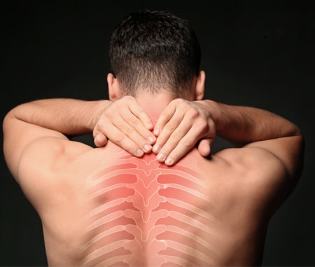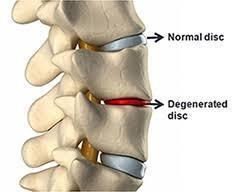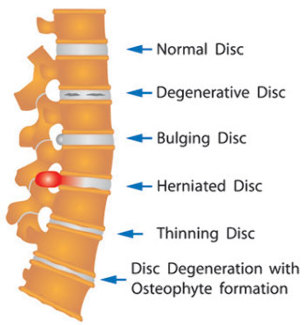
Diseases of the osteochondrosis is the most common disease of all diseases of the spine. Such as osteochondrosis, right, is a way of dystrophic-degenerative defeat of the disks located between the vertebrae, then, in consequence, it leads to their irreversible changes in the structure and form of the discs.
With the increase in the age of the person referred to changes in his spine are developing more and age, about 40...45 years osteochondrosis sick almost everything. Itself osteochondrosis of the thoracic spine develops much less frequently than, for example, the lumbar or the cervical spine, because the vertebrae in it much less mobile than in other vertebrates the premises. In addition, the area of the back in the chest area is more developed corset of muscles, responsible for the support of the spine in the thoracic region, it is much better than the other.
That is this thoracic osteochondrosis?
Thoracic osteochondrosis directly represents the bundle of the discs between the vertebrae, while reducing their thickness and, as a consequence, followed by a pinching of the nerve endings that are in the intercostal area of the chest of a man.
However, once again note that, due to the fact that the physiological determination of the ribs in humans is quite difficult, then the separation of the spine in the chest area less all prone to the disease osteochondrosis.
Usually this process pathology to involve the discs between the vertebrae of the thoracic department, including twelve thoracic vertebrae. But most often in osteochondrosis of the breast department of pathological changes occur in Wernigerode vertebrae. There are several degrees of lesions of the thoracic osteochondrosis, and the next, we will discuss them in detail.
Predisposing factors for development of thoracic degenerative disc disease
The exact causes of the degenerative disc disease of the thoracic department of modern science until the end, until they are established. At this point, decided to allocate in the medicine the following predisposing factors or so-called - risk factors:
- hereditary predisposition;
- excessive physical load;
- injuries of the spine, like something, for example a fall or contusion;
- changes occurring with age in the intervertebral disks, and leads to a reduction in hydration in the tissues of the disc;
- violation of blood supply in the chest area.
The causes leading to the diseases of the osteochondrosis of the thoracic spine
In the main extent of the disease osteochondrosis, in general, contributes to the lack of movement, it is the lack of muscular exertion, which leads to the weakening of the functions of the muscular corset and, as a consequence, increase the load on the intervertebral disks and volumes.
Other causes of the development of thoracic degenerative disc disease are also:
- hypothermia of the organism;
- the presence of chronic stress situations;
- delegated infections;
- severe conditions of physical work;
- incurred by hormonal disorders in the body;
- violation of the process of metabolism in the body;
- the presence of congenital abnormalities of the spine.
In the course of exposure collectively referred to factors, or sometimes even one, discs between the vertebrae in the course of time develop dystrophic-degenerative irreversible processes:
- purposee core of the intervertebral disc gradually begins to lose fluid, which stood them to ensure the lubricating function, which ultimately significantly reduces the depreciation function of the disk;
- further, the fibrous ring of the vertebrae, due to an increase in the load on it, it becomes more sensitive, which leads again to its gradual destruction.

Symptoms of thoracic degenerative disc disease and its symptoms
Clinical symptoms of thoracic degenerative disc disease is completely dependent on such factors:
- the age of the patient;
- the degree of disorder of the disease;
- stages of degenerative disc disease of the thoracic spine: remission or exacerbation.
The main characteristics of degenerative disc disease of the thoracic department are:
- chest pain in the spine, the so - called Dorigo;
- painful damage to the nerve endings of the spinal cord – radiculopathy;
- abdominal syndrome;
- heart syndrome or changes the heart muscle, with typical pain, persisting even under the influence of nitroglycerin;
- pulmonary syndrome, in the form of stagnation in the lungs with symptoms of hypoxia, i.e., suffocation.
Increase in body temperature in a patient during thoracic osteochondrosis, not to see, that is also a direct difference-diagnostic feature. Dorsalgia in thoracic region points to the occurrence of cracks in the fibrous ring and the deformation of the nucleus pulposus. In the implementation palpate, pain in this area of the rib cage just bigger.
In addition, the characteristic symptoms of thoracic degenerative disc disease in the compression of myelopathy, then there is a deformation of nerve endings, are:
- the feeling of "chills" - paresthesia;
- pain on the go in this way nerve;
- decreased sensitivity to temperature and to the touch;
- disorders in the spine motor function.

The extent of the disease thoracic osteochondrosis
Different degrees of disorders of the thoracic osteochondrosis are characterized by each pathology, each of which are own only their clinical symptoms. Modern medicine excels in four degrees of degenerative disc disease of the thoracic department and, respectively, the four periods of its development. Let us consider it in more detail.
The first degree, for which is characteristic is what is inside the fibrous rings cracks are formed, to which subsequently penetrates the purposee core. The current period of development of diseases of the thoracic osteochondrosis is characterized by the following characters:
- the emergence of pain in the back in the place of his defeat, but not with a view outside of the localization of the occurrence of the disease;
- referred pain can wear as a permanent character, and be in the form of lumbago;
- can be convulsive muscle contraction, along with pain in the heart area.
The second stage, as a developmental period of thoracic degenerative disc disease, is characterized by a morbid appearance of increased intervertebral mobility with these clinical manifestations:
- appear subluxation in the thoracic region of the spine;
- the pain is getting worse when moving;
- appears discomfort during long-lasting posture.
The third stage, characterized by the period when the torn fibrous ring and beyond its limits beyond the purposee core. In this period of the disease osteochondrosis of the thoracic spine is beginning to emerge intervertebral hernia, clinical signs, which are quite difficult. Namely – neuro-vascular, muscular-tonic and reflex-a degenerative.
In addition to that, the third degree of degenerative disc disease of the thoracic department is characterized by an alternation of these conditions of the spine:
- the weak fixation of the provisions of the spine;
- restrictions on the mobility of the vertebrae of the department, is well evident in the form of kyphosis or scoliosis.
The fourth degree, in connection with this period, in which dystrophic-the degenerative process affects all designs that are in the middle of the spine. In this disease involved yellow, interspinal and other volumes, and in the structures surrounding the spine, there is fibrosis. In this period of the disease thoracic osteochondrosis, clinically it is observed the so-called, the state of remission.
The complications that are possible when breast osteochondrosis
In the further progression of the disease thoracic osteochondrosis, perhaps, that the development of related complications, such as:
- inflammation of the nerve endings of the spinal cord;
- the appearance of intervertebral hernia;
- the development of vascular dystonia;
- the development of a hernia Schmorl's;
- disease spondylosis;
- pathological overgrowth of the bone growths - osteophytes;
- a significant reduction in spinal canal.
It should be noted that the degree of the severity of the resulting complications in breast osteochondrosis depends entirely on the pace of progress of the process of the newly formed disease, and, of course, from the effectiveness of treatment of degenerative disc disease of the thoracic spine.

Diagnosis of thoracic degenerative disc disease and his methods
In practice, several methods for the diagnosis of thoracic degenerative disc disease. Of them the most common is the xray of the study, the results of which are quite enlightening. Symptoms of thoracic degenerative disc disease, identified in this research are:
- the broken contours of the discs between the vertebrae;
- the edge of the skin plates purchased a wavy character;
- the intervertebral discs change their shape;
- incurred osteophytes – pathological bone growths;
- enlarged and sharpened hooked processes of the vertebrae;
- the body of the thoracic vertebrae changed its normal shape;
- significantly reduce the size of the height of the discs between the vertebrae;
- arise herniated discs between the vertebrae.
In some cases, there is practiced a method of diagnosis of thoracic degenerative disc disease by x-ray contrast stock, which determines the following symptoms of this disease:
- in the case of running the pathology of the contrast agent fills the disk between the vertebrae completely;
- with the help of a contrast agent visible to the contours of the nucleus pulposus, known uneven character;
- when the breakdown of a herniated disc is largely a contrast substance penetrates its borders, and it's up to the penetration into the spinal canal.
Treatment of thoracic degenerative disc disease
The implementation of the treatment of thoracic degenerative disc disease is possible in one of the following ways used with regard to the results of the diagnosis of thoracic degenerative disc disease, and that:
- conservative-traditional treatment;
- treatment of thoracic degenerative disc disease by using the traction;
- operationally-surgery.
Nothing new, of course, there is still I don't think, and as such, the treatment of thoracic degenerative disc disease, the so-called conservative, is no longer the traditional for the treatment of any kind, degenerative disc disease. In any case, it is always advantageous to conservatively-medical way of treatment of thoracic degenerative disc disease through the appointment of a non-steroidal anti-inflammatory drugs, aimed at the relief of painful sensations. It should be noted that these drug products very well eliminate the inflammatory processes, and also incur swelling, contributes to the reduction of the process of compression of the nerve roots. In more complex cases, disease of the thoracic osteochondrosis, the attending physician may prescribe additionally a number of drugs, for example, some strong painkillers and muscle relaxants, which block the formation of muscle cramps.
When the pain subsides, or it managed to stop, that is, at the time of remission, is associated with additional treatment of physical therapy, as well as, in addition, exercise therapy and massage. The main means of fighting, and the prevention of this disease in the treatment of physical therapy is magnetic therapy through special medical devices.
In addition to the above, for the treatment of thoracic degenerative disc disease can successfully exercise and traction treatment, i.e. the treatment of thoracic degenerative disc disease using a special traction. In this method, paravertebral muscles, tissue and ligaments are subjected to stretching, which leads to an increase in the intervertebral distance. Even one and a half millimeters will be enough to reduce swelling, removal of the squeezing, as well as relieving tension in and around the spine, the muscles.
And here is a surgical intervention is appropriate only when the above methods of treatment of thoracic degenerative disc disease do not give the desired result.




























